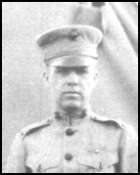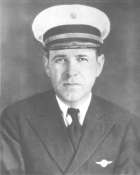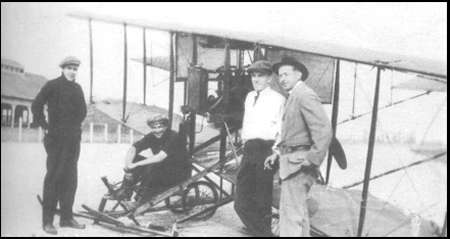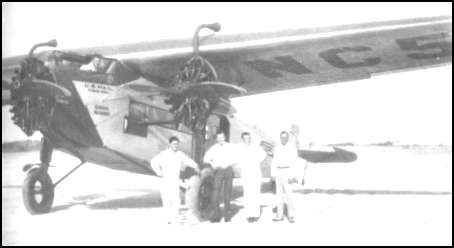


BIOGRAPHY |
 |
 |
 |
17 years of age From Crate to Clipper |
Miami, 1928 From Crate to Clipper |
Pioneer Pilot of the Air Acme Newspictures Inc. |
|
Musick was licensed to fly any type of plane, and he was given every opportunity to prove this in his position as Pan American's premier pilot. During his work for the airline, Musick set ten world records including making the inaugural flight to the Pacific aboard the China Clipper flying boat. The China Clipper's momentous flight cemented Musick's place as a modern day hero. Although his Pacific journey from California to Manila on the China Clipper wa perhaps his most famous flight, he was also legendary for breaking the isolation of the remote Pacific island of New Zealand. Flying the Samoan Clipper from San Francisco to New Zealand, Musick received an unprecendented welcome when thirty thousand New Zealander's turned out to greet him. A man of notorously few words, Musick addressed the wildly cheering crowd by saying only "We are glad to be here." Pan American's decision to fly to New Zealand was the result of strained relations between Pan American Airways and Great Britain and her colonies. While Tripp's Pan American Airways dominated the skies on routes throughout North and South American and the Pacific Islands, they were unable to come to an agreement to fly to Britain and her colonies. Britain would not allow Pan American to land on British soil before their Imperial Airways could reciprocate. After waiting for years for a shared Atlantic route agreement with Imperial. Trippe decided to look into his other options worldwide. On March 11, 1937, New Zealand broke rank with Australia and Britain to allow Pan American to fly there and Pan American quickly sent Musick on yet another historical journey. Despite a career as a meticulous and focused pilot, Musick was not indestructible. On January 11, 1938, Musick took off from Pago Pago piloting the Samoan Clipper to begin a survey flight and soon after the flight began, he reported an oil leak in engine number 4. In an attempt to assure a safe landing, he made the fateful decision to dump fuel in order to lighten the plane . The decision proved disastrous when fuel vapors collected in the wing structure causing the plane to explode in mid-air. The US Navy ship Avocet recovered the scattered remains of the clipper that evening. At the time of his death, Musick was unquestionably the world's most famous pilot. His face graced the cover of Time Magazine and he was awarded the Harmon Trophy for his work. Musick's accident ended his life at the height of his career and he was greatly mourned. His illustrious career has earned him a place of honor in the annals of early commercial aviation. On their site you will read: These fine art photographs and travel posters depict some of the greatest moments in early commercial flight in America." |
 |
Paramount Photo Service |
|
|
 |
to fly between Key West and Havana |
|
He liked Juan Trippe's the best of all. Trippe had organized a company known as Pan American Airways. For two years he had tried in vain to interest the government in the idea of a foreign air-mail service. Finally he had persuaded his friends in Wall Street and in the aviation industry to finance his project. The first step was to be an airline hook-up between the United States and Cuba. They had arranged for an inaugural ceremony in Havana to be headed by General Machad, President of Cuba. When Ed opened the throttles the morning of the flight at 8:30, he had nearly a ton of mail aboard. He set a course for Havana. For half an hour the weather was clear. Then he began to run into rain squalls. He dodged the worst ones, only to find the Cuban coast obscured by a far-reaching downpour. Morro Castle shot past, barely visible through the heavy rain. He scraped across the roofs of Havana on his way to Camp Columbia Airdrome. Anxiously he peered through the blurred windshield, striving to locate the field. The government party, waiting in the big hangar, included several Cuban aviators. They assured President Machado that it was impossible to fly in such a cloud-burst. He was preparing to leave the field when from overhead came the roar of airplane motors. Everyone rushed to the windows. Nothing could be seen of the plane. The sound of the motors died. It burst forth again as the Fokker landed, and taxied across the sodden field. The crowd broke into cheers as the dripping ship was hauled into the hangar. In sonorous accents President Machado proclaimed Cuba's gratification in this new tie which would bind her closer to her great sister republic to the north... |
|
|
|
If time permits, I heartily recommend that you read some of the other biographies and visit some of the photo album pages which offer previously unpublished and very important photographs. You can access them from the front page of the site. |
|
FROM CRATE TO CLIPPER WITH CAPTAIN MUSICK, PIONEER PILOT by William Stephen Grooch. Longmans, Green and Co., New York - Toronto, 1939 In his "Acknowledgments" Mr. Grooch writes For several years previous to his death, Captain Musick had been one of my closest friends. We had shared in the development of a transoceanic airline. In October of 1937 he and Mrs. Musick were guests at my home in La Mesa, California. During his visit we had many long talks about our experiences in aviation. Shortly after he was lost in the Samoan Clipper, Mrs. Musick requested me to write this book. She turned over to me his complete files. These included his flight logs, old letters and newspaper clippings, some of which dated back to 1912. With Mrs. Musick's kind assistance, I was able to locate and interview many of his friends of those early days. His flying mates in Pan American Airways have contributed generously from their personal recollections of his exploits. To all of these I am most grateful for the information they supplied. One of them was brave Captain Terletzky who was recently lost with the Hawaiian Clipper between Guam and Manila. I particularly wish to thank: Captain Musick's mother Harry Reynolds of Los Angeles A.C. Burns of the U.S. Dept. of Commerce for Aviation D.G. Richardson of Brownsville, Texas A.E. Curtis of Miami, Florida H.A. Bruno of New York City Captain W. D. Culbertson of Alameda, California W.S.G. |


|